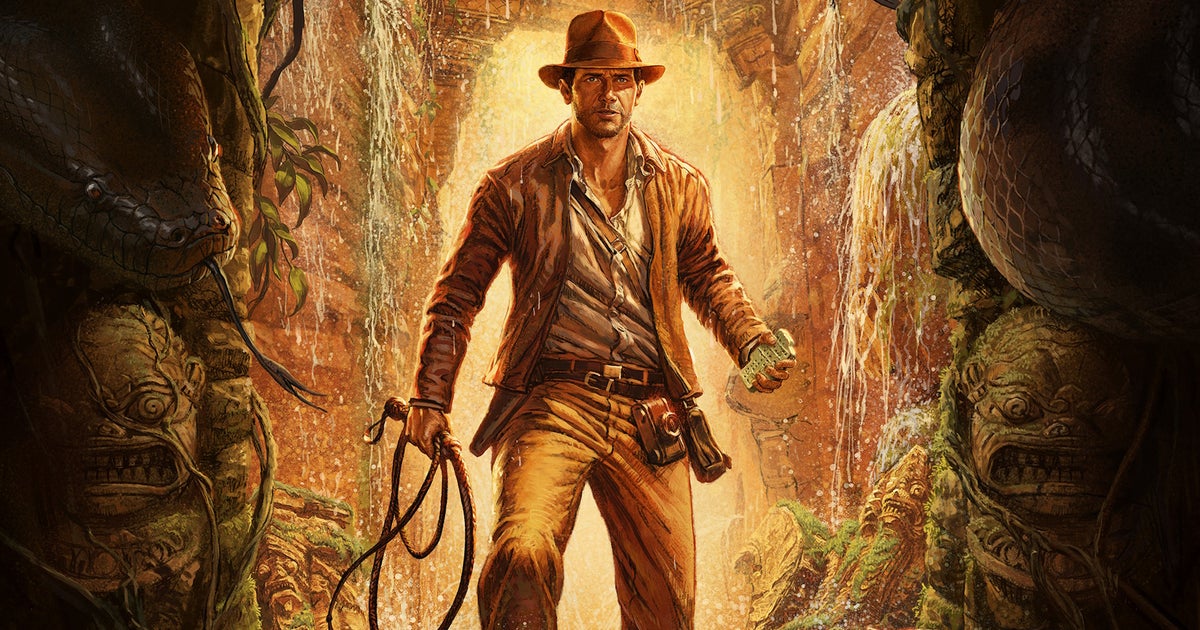
- Action Adventure
- Bethesda Softworks
- Exploration
- First person
- Indiana Jones and the Great Circle
- MachineGames
- Narrative / Story Driven
- PC
- Puzzle
- Single Player
- Stealth
- Story Rich
- Third person
- Xbox Series X/S
I’ve played three hours of Indiana Jones and the Great Circle, and it nails the films’ whip-cracking sense of adventure
Don’t you just love it when a developer treats a renowned film series with the respect it deserves? Last year’s Robocop: Rogue City was a great example of this recently, giving fans the chance to step into Robocop’s, err, Roboboots and visit some of its most iconic locations, as well as meet up with familiar faces from the movies. Well, you can add Indiana Jones and the Great Circle to the list of great game film adaptations, as that’s the exact vibe I got after playing three hours of MachineGames’ upcoming Indy adventure at a recent press event.
Right from its introductory chapter, The Great Circle opens with a wonderful recreation of Marshall College, the place where Indiana Jones teaches wannabe archaeologists when he’s not off stealing weird things that have been supposedly touched by Jesus or something. As you might expect, it’s stuffed full of Indy easter eggs, and on the big beefy PC I was playing on, it looked absolutely stunning. If my preview time hadn’t had a strict time limit, I think I could have spent a good hour or so poking around the office and classrooms and just drinking in all the little details (honestly, this game is begging for a VR mode, just saying).
There was another very familiar face there, too, in the form of Marcus Brody. Both he and Indy chat quite a bit in this opening section, and you can see developer MachineGames has paid just as much attention to The Great Circle’s character models voices. You’ll be pleased to hear (literally) that Troy Baker does a great gruff Indy voice, and sounds pretty much spot on with a young Harrison Ford. In the wrong hands, this might have been the most distracting thing about The Great Circle, but thankfully MachineGames has chosen wisely on this one.
It’s during this opening chapter that we also get introduced to the game’s potential villain: Locus, who’s played by Tony Todd from Candyman fame (although I wouldn’t be surprised if there’s a twist there and he ends up being a good guy, he just has that kind of vibe). Indy bumps into Locus as he’s burglarising artefacts from the college displays and, after a brief scuffle which ends in Indy getting knocked out, we’re introduced to how The Great Circle’s puzzles work. You see, The Great Circle wants you to feel like an adventurer and an archaeologist, and a large portion of its puzzle can only be solved through a bit of detective work, and by paying attention to both visual and aural clues around your environment.
For instance, in this early section, Indy and Marcus need to work out what artefact Locus has snaffled, and to do that, the player needs to pick up all the discarded artefacts and place them back in their correct places. A simple task on paper, perhaps, but in practice, I had to consider hints found on the artefact itself, matching them with descriptions of the artefacts found on the damaged display and even listen carefully to conversations between Indy and Marcus. Taken altogether, this extra detective work made it feel much more in keeping with the spirit of the movies.
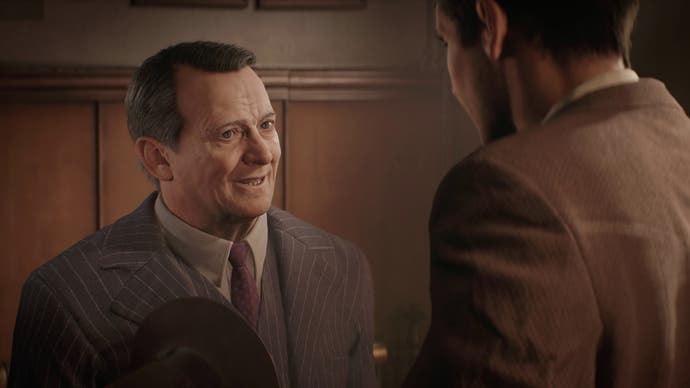
Speaking of the films, I must mention the maps. Rather than being displayed on a pause screen, the maps in The Great Circle are physical items that Indiana holds in front of him as he wanders around. It’s a simple little thing, really, but this goes a really long way to making you feel like a proper explorer, rather than a waypoint follower. There are, of course, waypoints you need to head to on the map, but the physicality of holding the map as you move makes the whole thing feel much more immersive and creates a much more believable ‘treasure hunter’ vibe. You don’t start with these maps, either – you have to find them as physical objects in the world. But once you have one, you can use it to search for out of the way areas that might contain things like a collectible newspaper clipping or a new archaeological puzzle to solve.
This brings me nicely to my next point, as during my preview session, I played three different levels which were all open world-lite sandboxes of varying sizes. Marshall College was easily the smallest of three, but this was followed by a medium-sized Vatican level, and an even larger Giza section. But more on that in a second.
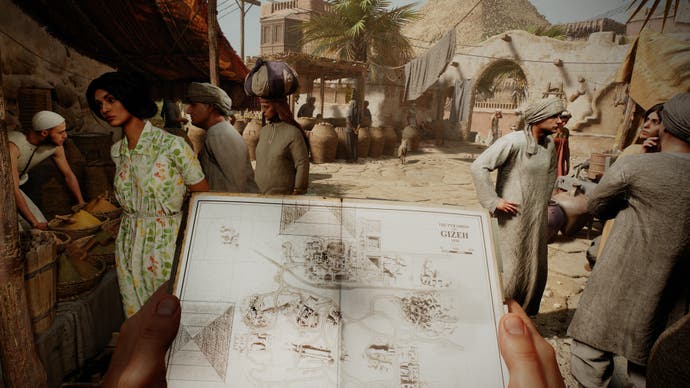
First, let’s talk about the Vatican, which showcased a bunch of different routes players could take through it depending on their playstyle. For instance, at one point I was able to use Indy’s whip to climb up onto a ledge and sneak past a guard in order to avoid combat. There was also a bit of light exploration to find and unlock a door after discovering a key stashed in a guard house, and towards the end of the level, there was a gate that led straight back to the starting area for some Souls-style backtracking – just in case you want to go and find all the collectibles and secret areas you missed first time around. There were a lot of gates like this to find during this section, some of which were easy to find, while others needed a bit more of that archaeological detective work I mentioned earlier. Case in point: one door was disguised as a painting and was flanked by two bull ornaments which had to be twisted around until their position matched an old drawing.
Giza, on the other hand, was even larger, though still quite small compared to something like, say, a Sniper Elite level. This one felt the most alive and organic, with NPCs wandering around having conversations as Nazi soldiers stood guard or patrolled set areas. In typical open-world fashion, Indy has a main objective to follow – head to a blue tent to meet a contact called Dame Nawal – but it’s up to the player if they want to do that straight away or just go off to find some tombs to explore. There are lots of optional, incidental treasure troves to find in these little offshoot areas, though following the main story path also threw plenty of other objects in my path as well, and a lot of the things I stumbled on ended up being tied to missions given to me by Nawal anyway.
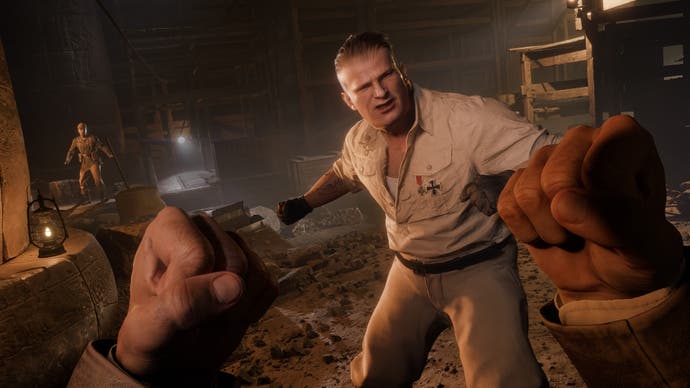
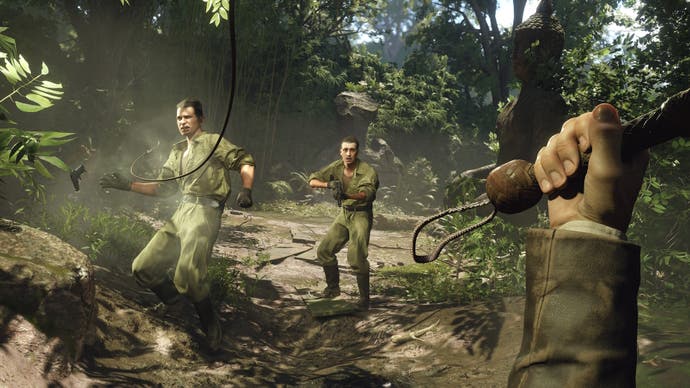

One thing that particularly made this level stand out, though, was seeing Indy start to panic when he had to feed Nawal’s pet snake. This all took place in the background while Gina (Indy’s companion at this point in the game) and Dame Nawal laid down some fairly hefty layers of exposition. Finally, one thing to note about larger maps like Giza is that you’re able to fast travel around them using signposts, although obviously you have to find those signposts first before you can use them.
As you’d expect, there will be plenty of Nazi soldiers stopping you from accessing certain areas, and while combat in The Great Circle isn’t always optional, most of the time it is, especially when it comes to guns. Indy has a pistol with him, but we were advised to use it sparingly in our preview session, as the noise would alert other enemies to Indy’s location (who’d inevitably bring their own firearms to the fight, too). Indy may be a good brawler, but I found he’s way squishier than the likes of Nathan Drake and Lara Croft when it comes to bullets, so ideally, you’ll want to avoid big gunfights completely, as that will likely result in a very quick game over screen.
Instead, you’ll want to employ stealth and fancy fisticuffs to advance without causing a scene. What I enjoyed most about this approach was the Jackie Chan-style way I was able to use pretty much anything that was lying around to clobber enemies with – things like vases, or bottles and at one point even a rolling pin. Like A Dragon’s Ichiban and Kiryu would be proud. There’s an awesome sense of experimentation to Indy’s combat, and I laughed out loud when I tried to knock out a very large enemy by throwing a fire poker at his head, only for it to clang off his skull and send him into a rage. Regardless of whether this was a situation intended by the developers or not, it felt like a classic, slapstick Indy movie moment. The best thing The Great Circle’s combat, though, has to be the punch noises. They are perfect, and I could literally listen to them all day. They just make the hand-to-hand combat feel so meaty and brutal. That’s not to say Indy’s quieter stealth moments aren’t just as enjoyable, though. Hitman fans will be particularly pleased, I think, as not only are you able to find disguises to wear in some of the levels, but you can also avoid alerting enemies by picking up and hiding dead bodies in dark corners.
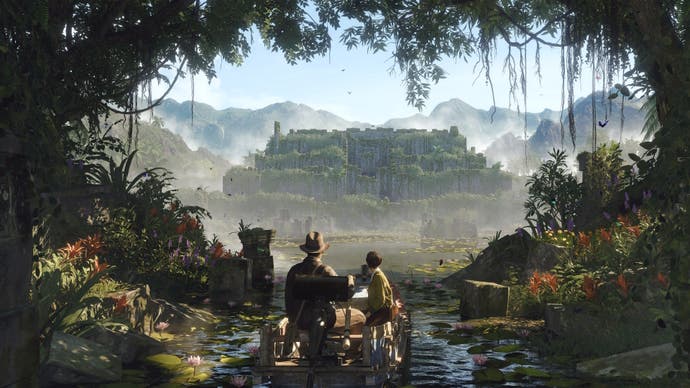
But let’s not forget Indy’s classic whip, which is so much more than a tool for disarming Nazis. As much as it feels great to flick a pistol out of a soldier’s hand (and watch them wave their injured hand in pain as they yelp out in surprise), the whip really comes into its own when it comes to traversing The Great Circle’s large environments. As mentioned above with the Vatican level, the whip lets you latch onto shortcuts and climb up to vantage points on the map. The interesting thing, though, is while the game is mainly played from a first-person perspective, the camera will cut to third-person when Indy uses the whip to climb. This change in perspective could easily be jarring but it’s done pretty well here, and the transition felt pretty seamless in the moment.
Speaking of climbing (and running around more generally), Indy has a stamina bar you need to keep an eye on here, which can be topped up by staying still, or eating random foodstuffs, such as a biscotti I found nosing around the Vatican. A blessed find, indeed. Losing stamina doesn’t seem to make Indy fall from walls, though. I know because I tried. He just kind of hangs there awkwardly and goes slowly until he gets his breath back – handy when it comes to not biffing tricky climbing puzzles, I guess, but less good when he’s trying to escape from people shooting at him.
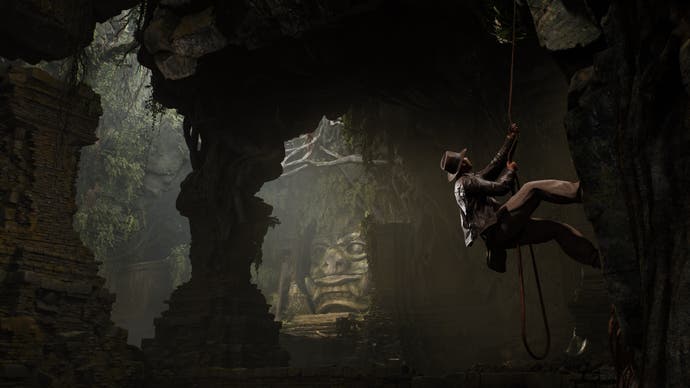
Hopefully some of this will be mitigated by Indy’s growing collection of Adventure Points. These can be used to unlock new skills for Indy as the game progresses, and you’ll have to earn them from completing specific actions, such as finding artefacts, solving puzzles and photographing interesting things. You see, Indy has a camera with him on this adventure, and if you zoom in and photograph specific objects, you’ll get a hint about how to complete a puzzle, gain extra lore about it from your companions, or earn Adventure Points. Once again, it all works to ground Indy in the world around him and makes you feel like a treasure hunter archaeologist, which I really enjoyed.
As an example, I was awarded some adventure points by photographing a cheeky little monkey at the market in Giza, which I was then able to spend on upgrading my skills – one of which could give Indy a second wind when he’s near death, giving players a short amount of time to crawl towards his signature hat to get him back in the action. Lots of skills can be improved over time, too, though you’ll need to find their requisite upgrade books first, which are hidden around the environment. As a result, you’ll always want to be on the lookout for clues and secret passages, as worthwhile treasures are always just around the corner.
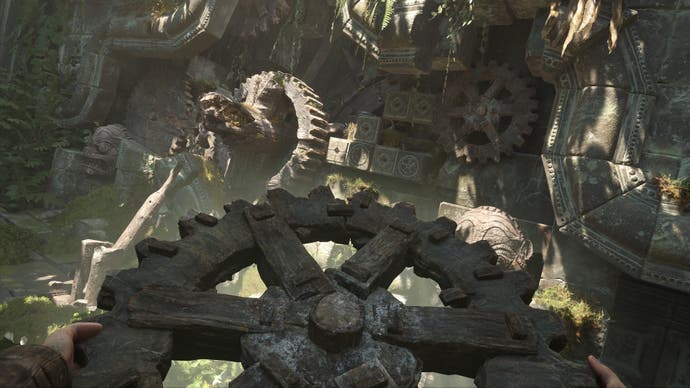
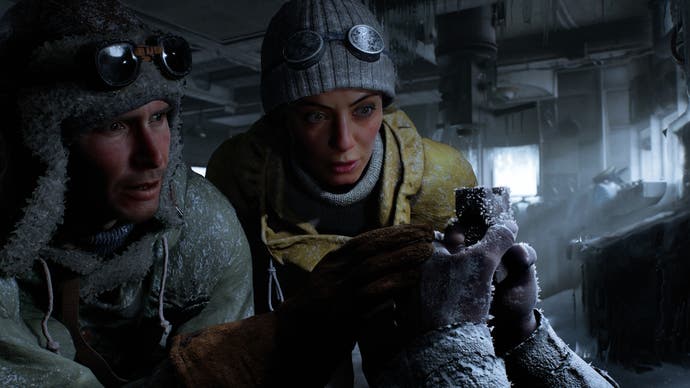
There is one unfortunate ‘but’ to all of this, though. While I enjoyed about 95 percent of what I played, I couldn’t help but think that the tomb raiding puzzles (or at least the ones I tried underneath the Sphinx in Giza) were a bit of a case of ‘been there, done that’ in terms of their design. One of them, for example, involved moving mirrors to direct beams of light so that they bounced around the room to unlock a door. And look, I realise the options for making historically-appropriate puzzles are probably quite limited (after all, the people who would have supposedly made these back in the day likely only had light, stone, sand and spikes to work with anyway), but the old light beam puzzle is such old Fedora in video games now that it was a bit of a yawn fest to go through two or three of them in a row.
Of course, spike traps, sand traps, twisting a thing to match another thing and finding your way through the dark with only an old torch and some matches is all very Indiana Jones, so in some ways it’s in keeping with the films and all that. At the same time, though, because I’d done them before in other games, they no longer had that sense of discovery. I no longer felt like I was raiding a tomb that had been left untouched for thousands of years, I just felt like I was retreading old ground, following in the footsteps of other adventurers who had walked there before.
In fairness, that’s the only big criticism I took away from my time with The Great Circle, and outside of those somewhat tired puzzles, I think it’s going to be something truly special and I can’t wait to play more of it. It’s shaping up to be a wonderful love letter to Indiana Jones, just like Rogue City was to Robocop, and anyone who counts themselves a fan of the movie trilogy (there’s definitely only been three movies, don’t know what you’re talking about) should definitely have this on their radar.
fbq('init', '560747571485047');
fbq('track', 'PageView'); window.facebookPixelsDone = true;
window.dispatchEvent(new Event('BrockmanFacebookPixelsEnabled')); }
window.addEventListener('BrockmanTargetingCookiesAllowed', appendFacebookPixels);

